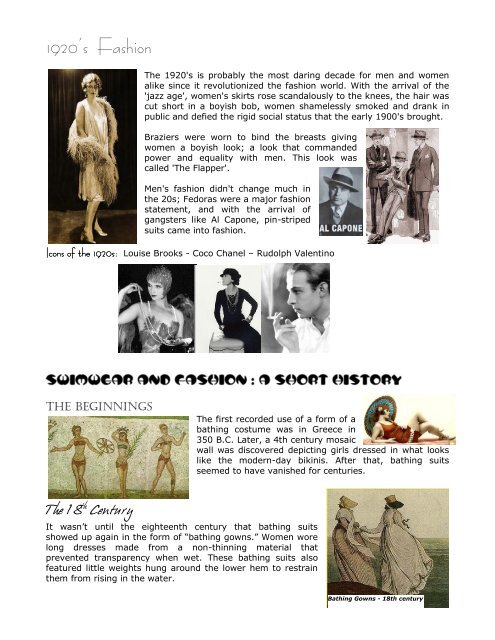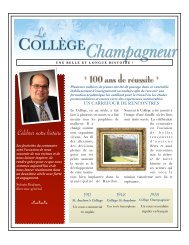Create successful ePaper yourself
Turn your PDF publications into a flip-book with our unique Google optimized e-Paper software.
1920’s <strong>Fashion</strong><br />
The <strong>1920's</strong> is probably the most daring decade for men and women<br />
alike since it revolutionized the fashion world. With the arrival of the<br />
'jazz age', women's skirts rose scandalously to the knees, the hair was<br />
cut short in a boyish bob, women shamelessly smoked and drank in<br />
public and defied the rigid social status that the early 1900's brought.<br />
Braziers were worn to bind the breasts giving<br />
women a boyish look; a look that commanded<br />
power and equality with men. This look was<br />
called 'The Flapper'.<br />
Men's fashion didn't change much in<br />
the 20s; Fedoras were a major fashion<br />
statement, and with the arrival of<br />
gangsters like Al Capone, pin-striped<br />
suits came into fashion.<br />
Icons of the 1920s: Louise Brooks - Coco Chanel – Rudolph Valentino<br />
The Beginnings<br />
T he 1 8 th Centur y<br />
It wasn’t until the eighteenth century that bathing suits<br />
showed up again in the form of “bathing gowns.” Women wore<br />
long dresses made from a non-thinning material that<br />
prevented transparency when wet. These bathing suits also<br />
featured little weights hung around the lower hem to restrain<br />
them from rising in the water.<br />
The first recorded use of a form of a<br />
bathing costume was in Greece in<br />
350 B.C. Later, a 4th century mosaic<br />
wall was discovered depicting girls dressed in what looks<br />
like the modern-day bikinis. After that, bathing suits<br />
seemed to have vanished for centuries.<br />
Bathing Gowns - 18th century
During that period, men and women still rarely bathed and the typical "swim" was a brief dip<br />
in the water with ladies on one side of the beach and men on the other.<br />
The 19 th Century By the mid 1800's bathing became considered<br />
a recreation whereas previously it had been<br />
merely a therapeutic device. People started<br />
swimming, surfing and diving, so the time was<br />
ripe for change in women's swimwear. The<br />
nineteenth century brought the two-piece<br />
bathing suits for the women, featuring a gown<br />
shoulder-to-knees over a set of pants<br />
extending to the ankles. Men had similar<br />
bathing suits, only without the gown.<br />
Women didn’t swim too much; the prevailing attitude of the day<br />
was that only men should swim. By the end of the 19th century, swimming had become an<br />
"art," as well as an Olympic sport. In this environment, it finally became acceptable for<br />
women to swim.<br />
The 20 th Century – 1900-1920<br />
The beginning of the twentieth century marked a new daring era. In 1909,<br />
Australian Annette Kellerman was arrested in the United States for wearing<br />
a loose, one piece suit. A couple of years later, swimsuits became shorter,<br />
showing a little more of the figure and allowing for exposure to the sun.<br />
A softer, more feminine style replaced the boyish, flapper look of the<br />
twenties. However, with the Great Depression and with the majority of<br />
people poor and without work, no one had much money to spend on<br />
leisurely things like clothes and shoes.<br />
The entertainment industry exerted a strong influence over fashion.<br />
Movies were one of the few escapes<br />
from the harsh reality of the<br />
Depression.<br />
As far as swimsuit <strong>Fashion</strong> goes, it’s<br />
during the 1930’s that swimsuits began<br />
resembling those of today.<br />
Marlene Dietrich, Greta Garbo,<br />
Clark Gable<br />
Swimsuits in the 30's<br />
Annette Kellerman
World War II set in. The men went off<br />
to war. The fashion for women was as<br />
conservative as possible so that extra<br />
material could be used to support the<br />
men at war. Mixing and matching<br />
became stylish in this era. To save<br />
money, people made bras and skirts<br />
from tablecloths (left) and suits from<br />
men's clothes.<br />
The 1940’s brought more feminine swimsuits that were more revealing.<br />
Swimsuits really needed experts to design garments that hid faults in a<br />
woman's shape. They achieved this by adding stretch tummy control<br />
panels to hold in the stomach.<br />
Lauren Bacall, Katherine Hepburn, Fred Astaire









